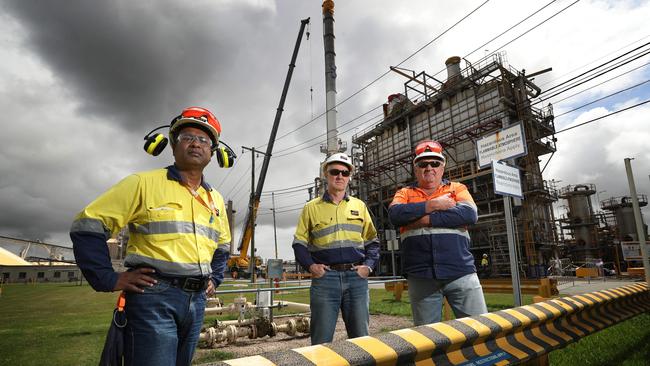Incitec plant, workers at risk over gas supply failure
Incitec Pivot has warned that its Gibson Island fertiliser plant and the 450 jobs it supports have been plunged into fresh turmoil.

Incitec Pivot has warned that its Gibson Island fertiliser plant and the 450 jobs it supports have been plunged into fresh turmoil, with the facility at risk of shutting down after failing to sign a new gas contract to start in 2020.
The company has yet to secure any gas offers for 2020-21 after issuing a tender to the market and is now contemplating whether it can keep the Brisbane plant open after failing to secure a supply deal.
The Queensland fertiliser and explosives maker has “no offers for supply for 2020 and 2021”, Incitec chief executive Jeanne Johns told The Australian. “We are looking to resolve that but if we are not able to resolve affordable supply, unfortunately we will be in a position that we need to shut the plant.”
The potential closure of Gibson Island underlines the tension in the east coast gas market between large industrial users and producers over a lack of supply and high prices, which threaten the viability of marginal manufacturing facilities.
A surge in gas prices to three to four times higher than historical levels this summer may force manufacturers and heavy industry to shutter operations, the competition watchdog warned earlier this month.
Ms Johns said more needed to be done to help local industry cope with one of its biggest input costs.
“It is imperative to require more Australian gas to stay at home and voluntary efforts have not worked,” Ms Johns said. We need to “create a competitive domestic gas market to lower gas and electricity pricing for Australian consumers and industry alike. Longer-term solutions — like more supply, ‘use it or lose it’, or point-forward reservation policies — will not have the impact in time to save Australia’s industrial sector.”
While Incitec recently managed to secure a 12-month lifeline — after its existing gas contracts with Shell’s QGC and Origin Energy’s APLNG export ventures expired on October 1 — it came at double the price.
A deal struck in June with Central Petroleum and Macquarie Group to receive piped gas from the Northern Territory to cover its need for 2019 added $50 million to its manufacturing costs due to increased prices.
However, it still has no firm gas supply options beyond December 2019.
Incitec opened a tender on September 12 calling for the supply of 15 petajoules of gas per year for 2020 and 2021 and asked producers to submit a range of proposals including trades, swaps and even an arrangement using a urea fertiliser price-linked formula.
Other options suggested by Incitec included creating a supply contract using a commodity-linked gas price in either Australian or US dollars, or using a traditional Australian dollar link to the consumer price index.
After calling for offers from 19 suppliers, Incitec said it received just one offer after closing the tender on October 3 and even that was for only 10 per cent of its volume needs.
The extension of a pledge in September by Queensland’s three LNG producers to offer uncontracted gas for domestic use before export was failing to bring sufficient supply to market, according to Incitec.
“It is clear from this tender the intent of the heads of agreement — ‘maintaining a secure and affordable gas supply to the domestic market’ — is not having its desired effect,” Ms Johns said.
Federal Labor has pledged a different approach where it would introduce a domestic gas price trigger to curb supplies of LNG exports, which has raised fears among producers over the risk of retrospective moves disrupting Australia’s second-biggest export earner.
The east coast domestic gas price is now linked to international LNG prices and markets after Queensland’s three export projects started shipping local gas to customers in Asia in the past few years, which effectively tied the two markets together.
The Australian Competition & Consumer Commission has started publishing netback prices for LNG — which represent export prices minus the cost of freezing the gas to LNG and shipping it to buyers in Asia — to help give a price estimate guide to local manufacturers when they are sourcing new contracts.
However, with prices surging beyond $12 a gigajoule, compared with historical prices of $3-$4 a gigajoule, it remains a battle, according to Incitec.
“Other long natural gas markets price domestic gas closer to $4 a gigajoule,” Ms Johns said. “This is US gas pricing — and similar to gas in WA and NT here in Australia. It is also eastern Australia’s historic pricing and was in effect when the three LNG projects were approved and built.”
Credit Suisse said the gas market remained constrained but it expects offers to be made, given federal government pressure.
“The market is tight, and buyers need to be willing to pay LNG netback-linked market prices to secure gas, which will prove too expensive for some gas-intensive manufacturers in the fertiliser sector,” Credit Suisse analyst Saul Kavonic said. “But we believe that any bona fide request for gas at market prices from large industrial gas buyers is likely to receive real offers from producers, given the sharp political microscope producers are under.”

